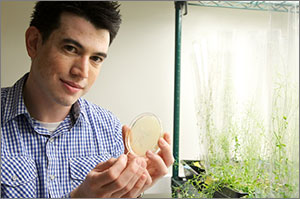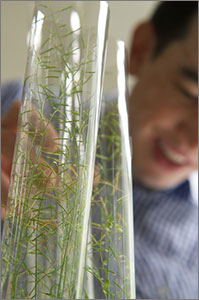Research holds implications for the production of new biofuels and other sustainable products
Wyss researchers are drawing inspiration — and genetic sequences — from a little-known bacterium, Chloroflexus aurantiacus, that lives in hot springs and carries out photosynthesis much more efficiently than the vast majority of plants on Earth.
Their goal is to insert the genes from C. aurantiacus responsible for the unique photosynthesis modus operandi into the iconic laboratory organism, E. coli, turning it from a bacterium that cannot make its own food into one that can. Succeeding in this quest means E. coli could become an efficient photosynthetic "engine" that the team can use to generate any number of sustainable products relevant to the production of biofuels, biopharmaceuticals, and bioplastics.

"While we haven’t hit the home run yet," said Matthew Mattozzi, Ph.D., a postdoctoral fellow at the Wyss Institute at Harvard University who is leading the charge, "we have made significant progress toward that goal."
The Wyss Institute team reported their results recently in the journal Metabolic Engineering, which marks the first publication to result from funding they received from the Advanced Research Projects Agency-Energy (ARPA-E) to design a better biofuel.
A radically different approach to biofuels
Conventional photosynthesis — the process by which plants use carbon dioxide, water, and energy from the sun to fuel plant growth — has a serious flaw in the eyes of scientists who are trying to grow various plants in high numbers to make the next great biofuel: It is an inherently wasteful biochemical process.
Although it is responsible for most plant matter on Earth, conventional photosynthesis works inside plant cells in part by way of a metabolic pathway called the "Calvin cycle," which arose at a time early in Earth’s history when the atmosphere lacked oxygen. In effect, this means it doesn’t work as efficiently in the presence of oxygen.
Nevertheless, most scientists experimenting with different kinds of plants for the purposes of biofuel production are trying to find ways to boost the engine of conventional photosynthesis.
But Mattozzi and Wyss Staff Scientist Jeffrey Way, Ph.D., have a radically different approach to generating biofuels. Forget conventional, they say.
Enter Chloroflexus aurantiacus, a bacterium that lives in hot springs and uses a novel photosynthesis pathway called the 3-HPA cycle, which may work more effectively in the presence of oxygen — giving it a kind of photosynthetic ‘mojo.’

"This novel cycle may have evolved more recently in Earth’s history when oxygen was around," said Way, who asked a bold question with Mattozzi at the helm:
Can we insert the genes responsible for the 3-HPA cycle into E. coli, a bacterium extensively used in the labs for research, turning it from an organism that could not make its own food into one that can — and one that can do so much more efficiently than nearly all other plants on Earth?
If Mattozzi and the team can get the unconventional photosynthetic pathway to work in E. coli, they can essentially genetically program E. coli to generate whichever sustainable chemicals they want.
Mattozzi and Way’s coauthors included Wyss Core Faculty member Pamela Silver, Ph.D.; Marika Ziesack, who was a Master’s student at the University of Heidelberg at the time of the study; and Mathias Voges, then a Master’s student at TU Delft.
Getting closer…
Mattozzi’s long list of challenges in this metabolic engineering puzzle starts with the fact that the 3-HPA cycle is very complicated, which is why he started by dividing it into four key sub-pathways and fully understanding the enzymes involved in each.
The task was daunting: 19 enzymes are responsible for making the 3-HPA cycle work, and E. coli only naturally had three of them. He would have use genetic engineering tools to introduce a whopping 16 new enzymes into E. coli.

Another notable challenge in the process that Mattozzi has overcome was the fact that one of the reactions in the complicated 3-HPA cycle involves the production of a significant amount of "propionate," a substance that is toxic to bacteria such as E. coli.
After doing a few biochemical tests, Mattozzi discovered that another bacterium called Streptomyces coelicolor, a fairly common bacterium that lives in soil, detoxifies propionate even more quickly than C. aurantiacus could — so he tweaked yet again the genetic machinery of E. coli such that it now also incorporated the relevant genes from Streptomyces.
To date, Mattozzi has achieved full expression of all of the relevant genes from C. aurantiacus and S. coelicolor — just not all together at the same time. That’s his next step.
"The most exciting part of this advancement is that we’re that much closer to engineering E. coli such that it does not rely on sugar," said Mattozzi. Sugar is a necessary — and costly — intermediate processing step required to generate the most effective biofuels available today. For example, before corn can become biofuel, scientists first have to turn it into sugar. What’s more, much of the biofuel today is made from sugarcane itself, which takes up a lot of space and therefore can lend itself to deforestation or competition with food resources.
"If we can get E. coli to grow without sugar, we’ll be pretty excited to say the least," Mattozzi said.